Beech offers superior durability and a fine, uniform grain ideal for detailed moulding, while alder provides a softer texture with a warm tone, making it easier to carve and stain. Beech is preferred for high-traffic areas due to its hardness, whereas alder is often chosen for decorative moulding requiring a smooth finish.
Table of Comparison
| Property | Beech Wood | Alder Wood |
|---|---|---|
| Hardness (Janka) | 1,300 lbf | 590 lbf |
| Grain | Fine, straight, uniform | Fine, straight, slightly wavy |
| Workability | Good, requires sharp tools | Excellent, easy to carve and shape |
| Durability | High, resistant to wear | Moderate, softer and less durable |
| Finish | Smooth, takes stains well | Smooth, accepts paints and stains evenly |
| Cost | Moderate to high | Lower cost |
| Common Uses in Moulding | Durable trim, flooring mouldings | Decorative trim, furniture moulding |
Introduction to Beech and Alder Wood for Moulding
Beech and alder are popular hardwood choices for moulding due to their distinct characteristics and workability. Beech wood offers a fine, even texture with excellent strength and durability, making it ideal for detailed moulding profiles and staining to achieve a smooth finish. Alder wood is softer with a straight grain and uniform texture, providing ease of machining and a warm, reddish-brown tone that enhances decorative moulding applications.
Physical Characteristics of Beech vs Alder
Beech wood is denser and harder than alder, with a consistent fine grain that provides a smooth, durable surface ideal for detailed moulding work. Alder features a softer texture and more pronounced grain patterns, making it easier to shape but more prone to dents and wear over time. Beech's higher Janka hardness rating of around 1300 compared to alder's 590 enhances its suitability for high-traffic or impact-prone moulding applications.
Workability and Machining Differences
Beech offers superior workability and smoother machining due to its fine, even texture and hardness, making it ideal for detailed moulding profiles. Alder, being softer and less dense, machines easily but can produce a rougher surface, requiring more sanding for a refined finish. For precision moulding, Beech is preferred for its consistent grain and stability, while Alder suits projects where cost-effective, easy shaping is prioritized.
Durability and Strength Comparison
Beech wood offers superior hardness and strength compared to alder, making it more durable for moulding applications subject to wear and impact. Alder, being softer and lighter, is easier to work with but may dent or scratch more easily over time. For long-lasting moulding that withstands mechanical stress, beech is the preferred choice due to its higher Janka hardness rating around 1,300 lbf versus alder's approximate 590 lbf.
Aesthetic Qualities: Color and Grain
Beech moulding offers a pale cream to reddish-brown color with a fine, uniform grain that provides a smooth and consistent appearance, ideal for modern and minimalist designs. Alder moulding features a warmer, reddish-brown hue with a straight, slightly pronounced grain pattern that adds character and rustic charm to interiors. Both woods finish well, but Beech delivers a more subtle and sleek aesthetic, while Alder emphasizes natural texture and warmth.
Suitability for Staining and Finishing
Beech wood has a tight, even grain that makes it highly suitable for staining and finishing, offering a smooth surface that absorbs stains evenly and results in a consistent color. Alder, with its fine grain and softer texture, also takes stains well but tends to produce a warmer, reddish tone and may require sealing to prevent blotchiness. For moulding projects requiring a uniform finish and excellent stain absorption, beech is typically preferred, while alder provides a more natural, rustic appearance with a slightly varied finish.
Cost and Availability in the Market
Beech moulding is generally more expensive than Alder due to its denser grain and durability, making it a premium choice for fine woodworking. Alder is widely available and more cost-effective, favored in markets where budget constraints are paramount without sacrificing workability. Market availability of Alder remains high across North America and Europe, while Beech tends to be sourced mainly from European suppliers, influencing regional pricing and stock levels.
Environmental Impact and Sustainability
Beech wood offers high durability and is sourced primarily from managed European forests, making it a relatively sustainable choice for moulding due to responsible forestry practices and carbon sequestration capabilities. Alder, being faster-growing and often harvested from North American forests, has a lower environmental impact through reduced logging cycles and increased regrowth rates, enhancing sustainability in moulding applications. Both woods feature biodegradability and recyclability, but alder's quicker regeneration may offer a more eco-friendly option in terms of long-term environmental footprint.
Best Applications for Beech and Alder in Moulding
Beech moulding is ideal for interior trim and furniture due to its fine, uniform texture and excellent wear resistance, making it suitable for high-traffic areas. Alder moulding excels in decorative applications and painted finishes because of its smooth surface and ease of staining, providing a cost-effective option for aesthetic versatility. Both woods offer durability, but Beech is preferred for structural moulding, while Alder is favored for ornamental details.
Final Considerations: Choosing Between Beech and Alder
Beech offers a dense, hard texture with a uniform grain ideal for durable, smooth moulding finishes, while Alder provides a softer, more workable surface with a warm, reddish-brown hue that enhances natural aesthetics. Durability and resistance to wear make Beech suitable for high-traffic areas, whereas Alder excels in detailed carving and staining versatility for decorative mouldings. Final selection depends on balancing longevity and ease of customization to match the desired aesthetic and functional requirements of the space.

Infographic: Beech vs Alder for Moulding
 azmater.com
azmater.com